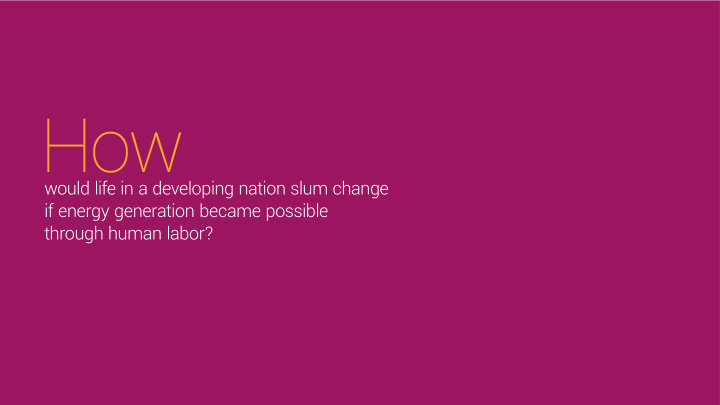



How would life in a developing nation slum change if energy generation became possible through human labor?
This is Dharavi. Population: 1,000,000 Dharavi is one of the largest slums in the world, situated in the heart of Mumbai.
Dharavi has 5000 businesses & 15,000 single room factories In addition to pottery and textile industries, it has the largest recycling industry in Mumbai.
The cost of redeveloping the slum is ~$2.8 billion dollars. Dharavi suffers from major housing, sanitation, and energy problems.
Two technological developments in the near future Piezoelectric + Graphene becomes the key material C 6 2H 2 O for energy storage making portable Energy batteries possible. Piezoelectrics become more widespread, resulting in energy generation through human labor.
The Energy Wallah One of the key roles to emerge from the economy of energy production in the slums is the powerful figure of the energy wallah, a role roughly analogous to that of the moneylender in south Asian society today. The energy wallah controls the flow of energy production, stockage and consumption in the slum: he stores energy in his large capacitors, supplies energy to the neighborhood, and loans energy to slum dwellers who need it, acting as the late 21st century equivalent of a traditional moneylender – he also buys energy from the poor in return for cash. Some energy wallahs, in order to meet the energy demands of their customers employ more insidious means to employ the many desperate souls persisting in the heart of the slums.
The Cycle Wallah Ancient professions like those of the many mobile service providers known as cycle wallahs now take advantage of new and cheap ways of producing energy through their daily labor to hoard energy as a means to both power their own products and homes, and hoard it as a form of wealth to be bartered for real cash if needed. In this way, energy comes to acquire a value for the poor much as gold or more material forms of wealth did for the rich, albeit one that is prone to more flow because of its utility.
Video: The Energy Wallah
Recommend
More recommend